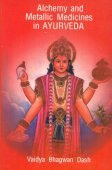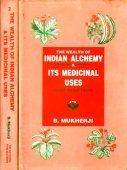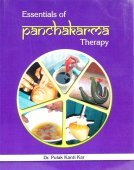Pancakarma, Pañcakarma, Pañcakarman, Pancan-karman, Pancakarman, Pamcakarma: 13 definitions
Introduction:
Pancakarma means something in Hinduism, Sanskrit. If you want to know the exact meaning, history, etymology or English translation of this term then check out the descriptions on this page. Add your comment or reference to a book if you want to contribute to this summary article.
Alternative spellings of this word include Panchakarma.
In Hinduism
Ayurveda (science of life)
Kalpa (Formulas, Drug prescriptions and other Medicinal preparations)
Source: Ancient Science of Life: Yogaśataka of Pandita VararuciPañcakarma (पञ्चकर्म) is dealt with in the 10th century Yogaśataka written by Pandita Vararuci.—It describes Pañcakarma as one separate branch from Kāyacikitsā. This may be the only book which describes Pañcakarma as an independent branch.
In Pañcakarma section, there is one stanza and preparation described for each Karma. (1) Vamana: Paste of Indrayava, Pippalī and Madanaphala (Randia dumetorum Retz.) mixed with Yaṣṭimadhu decoction is described for Vamana. (2) Virecana: Powder of Dantī (Baliospermum solanifolium Suresh), Citraka (Plumbago zeylanica Linn.), Pippalī and Biḍlavaṇa mixed with Harītakī decoction made up from Sauvīraka is used for Virecana. Castor oil is also recommended for Virecana. (3) Nirūha: One yoga for Nirūha Basti (Decoction enema) and (4) Anuvāsana: two yogas for Anuvāsana Basti (oil enema) is described. (5) Śirovirecana: Nasya of jaggery and Śuṇṭhi (dried rhizome of Zingiber officinale), Saindhava and Pippalī is described for Śirovirecana (errhine therapy).
Rasashastra (Alchemy and Herbo-Mineral preparations)
Source: Indian National Science Academy: Annual Report 2015-16 (rasashastra)Pañcakarma (पञ्चकर्म) is introduced (as a new set) in the Āyurvedaprakāśa: an exclusive text on Rasaśāstra the pharmaceutical wing of Ayurveda that concentrates on preparation of herbo-mineral medicaments, written in 17th Century AD by Mādhava Upādhyaya.
The pañcakarma for Rasaśāstra include:
- digestion (pācana),
- oleation (snehana),
- sudation (svedana),
- emesis (vamana),
- purgation (virecana).
Unclassified Ayurveda definitions
Source: Wisdom Library: Āyurveda and botanyPañcakarma (पञ्चकर्म) refers to an intensive detoxifying procedure with five components, and is used throughout Ayurvedic literature such as the Caraka-saṃhitā and the Suśruta-saṃhitā. The compound Pañcakarma is composed of the words Pañca (‘five’) and Karma (‘action, work’).
Source: Google Books: Essentials of AyurvedaPañcakarma (पञ्चकर्म, “five measures”):—For śodhana, five measures are employed which are collectively known as pañcakarma:—
- Vamana (‘emesis’),
- Virecana (‘purgation’),
- Āsthāpana (‘non-unctuous enema’),
- Anuvāsana (‘unctuous enema’)
- and Śirovirecana (‘head-evacuation’ or ‘snuffing’).
It has been modified further by including Raktamokṣaṇa (‘blood-letting’).
Source: eJournal of Indian Medicine: Memoirs of Vaidyas (3)Pañcakarma is a collective term for the five kinds of purificatory treatment in Āyurveda. There are some differences among the contents of Pañcakarma in each tradition and text. In the interviewee, Nair’s tradition, pañcakarma means
- enema (vasti),
- emesis (vamana),
- purgation (virecana),
- nasal insufflation (nasya),
- and bloodletting (raktamokṣa),

Āyurveda (आयुर्वेद, ayurveda) is a branch of Indian science dealing with medicine, herbalism, taxology, anatomy, surgery, alchemy and related topics. Traditional practice of Āyurveda in ancient India dates back to at least the first millenium BC. Literature is commonly written in Sanskrit using various poetic metres.
Purana and Itihasa (epic history)
Source: archive.org: Shiva Purana - English TranslationPañcakarma (पञ्चकर्म) refers to the “five organs of activity”, according to the Śivapurāṇa 2.5.5 (“The Tripuras are fascinated).—Accordingly, as Arihan said to the Lord of the Three Cities: “O ruler of the Asuras, listen to my statement, pregnant with wisdom. It is the essence of the Vedānta and bears high esoteric importance. [...] The hoarding and amassing of vast wealth is useful only for the propitiation of twelve organs of senses. Of what avail is the propitiation of other things? The twelve organs of senses are the five organs of activity (pañcakarma-indriya) and the five organs of knowledge together with the mind and intellect. [...]”.

The Purana (पुराण, purāṇas) refers to Sanskrit literature preserving ancient India’s vast cultural history, including historical legends, religious ceremonies, various arts and sciences. The eighteen mahapuranas total over 400,000 shlokas (metrical couplets) and date to at least several centuries BCE.
Languages of India and abroad
Sanskrit dictionary
Source: DDSA: The practical Sanskrit-English dictionaryPañcakarman (पञ्चकर्मन्).—n. (in medicine) the five kinds of treatment; i. e. 1 वमन (vamana) 'giving emetics'; 2 रेचन (recana) 'purging'; 3 नस्य (nasya) 'giving strenutatories'; 4 अनुवासन (anuvāsana) 'administering an enema which is oily', and 5 निरूह (nirūha) 'administering an enema which is not oily. वमनं रेचनं नस्यं निरूहश्चानुवासनम् । पञ्चकर्मेदमन्यश्च ज्ञेयमुत्क्षेपणादिकम् (vamanaṃ recanaṃ nasyaṃ nirūhaścānuvāsanam | pañcakarmedamanyaśca jñeyamutkṣepaṇādikam) ||
Pañcakarman is a Sanskrit compound consisting of the terms pañcan and karman (कर्मन्).
Source: Cologne Digital Sanskrit Dictionaries: Monier-Williams Sanskrit-English DictionaryPañcakarma (पञ्चकर्म):—[=pañca-karma] [from pañca] n. ([cf. Lexicographers, esp. such as amarasiṃha, halāyudha, hemacandra, etc.]) the 5 kinds of treatment (in medicine, viz. giving emetics, purgative medicines, sternutatories, and enemas of two kinds, oily and not oily)
Source: Cologne Digital Sanskrit Dictionaries: Monier-Williams Sanskrit-English DictionaryPañcakarman (पञ्चकर्मन्):—[=pañca-karman] [from pañca] n. ([Suśruta]) the 5 kinds of treatment (in medicine, viz. giving emetics, purgative medicines, sternutatories, and enemas of two kinds, oily and not oily)
Source: Cologne Digital Sanskrit Dictionaries: Yates Sanskrit-English DictionaryPañcakarman (पञ्चकर्मन्):—[pañca-karman] (rmma) 5. n. Five actions of the body, vomiting, evacuation by bleeding, or stool; excretion or perspiring, blowing the nose.
[Sanskrit to German]
Sanskrit, also spelled संस्कृतम् (saṃskṛtam), is an ancient language of India commonly seen as the grandmother of the Indo-European language family (even English!). Closely allied with Prakrit and Pali, Sanskrit is more exhaustive in both grammar and terms and has the most extensive collection of literature in the world, greatly surpassing its sister-languages Greek and Latin.
Kannada-English dictionary
Source: Alar: Kannada-English corpusPaṃcakarma (ಪಂಚಕರ್ಮ):—[noun] a treatment that includes emetics, purgative medicines, sternutatories and enemas of two kinds (oily and non-oily).
Kannada is a Dravidian language (as opposed to the Indo-European language family) mainly spoken in the southwestern region of India.
See also (Relevant definitions)
Partial matches: Karma, Panca.
Starts with: Pancakarmadhikara, Pancakarmavidhi.
Full-text (+4): Vamana, Virecana, Anuvasana, Shirovirecana, Pancakarmavidhi, Anuvasanabasti, Niruha, Anuvasanavasti, Niruhabasti, Niruhavasti, Nasya, Pacana, Snehana, Marmavijnana, Svedana, Netracikitsa, Balacikitsa, Parikartika, Asthapana, Malastambha.
Relevant text
Search found 9 books and stories containing Pancakarma, Pañcakarma, Pañca-karman, Panca-karman, Pañcakarman, Pañca-karma, Panca-karma, Pañcan-karman, Pancan-karman, Pancakarman, Pamcakarma, Paṃcakarma; (plurals include: Pancakarmas, Pañcakarmas, karmans, Pañcakarmans, karmas, Pancakarmans, Pamcakarmas, Paṃcakarmas). You can also click to the full overview containing English textual excerpts. Below are direct links for the most relevant articles:
Atharvaveda and Charaka Samhita (by Laxmi Maji)
Ūrustambha (spasticity of thigh) according to Caraka < [Chapter 4 - Diseases and Remedial measures (described in Caraka-saṃhitā)]
Hikkā (hiccup) and Śvāsa (asthma) according to Caraka < [Chapter 4 - Diseases and Remedial measures (described in Caraka-saṃhitā)]
Vāta-śoṇita (gout) and Vāta-rakta (arthritis) < [Chapter 4 - Diseases and Remedial measures (described in Caraka-saṃhitā)]
Charaka Samhita (English translation) (by Shree Gulabkunverba Ayurvedic Society)
Chapter 2 - The Fivefold Purificatory Therapy (panchakarma-siddhi) < [Siddhisthana (Siddhi Sthana) — Section on Successful Treatment]
Sushruta Samhita, volume 1: Sutrasthana (by Kaviraj Kunja Lal Bhishagratna)
Charaka Samhita and Sushruta Samhita (by Nayana Sharma)
The Student of Āyurveda (3c): Practical Knowledge < [Chapter 3]
Knowledge of Dietetics < [Chapter 7]
Epidemics (maraka) < [Chapter 6]
Sushruta Samhita, volume 4: Cikitsasthana (by Kaviraj Kunja Lal Bhishagratna)
Bhesajjakkhandhaka (Chapter on Medicine) (by Hin-tak Sik)
(b) Basic Principles of Āyurveda < [Chapter 2 - Background Information]
Conclusion: Summary of Present Research < [Chapter 6 - Conclusion]
Related products


